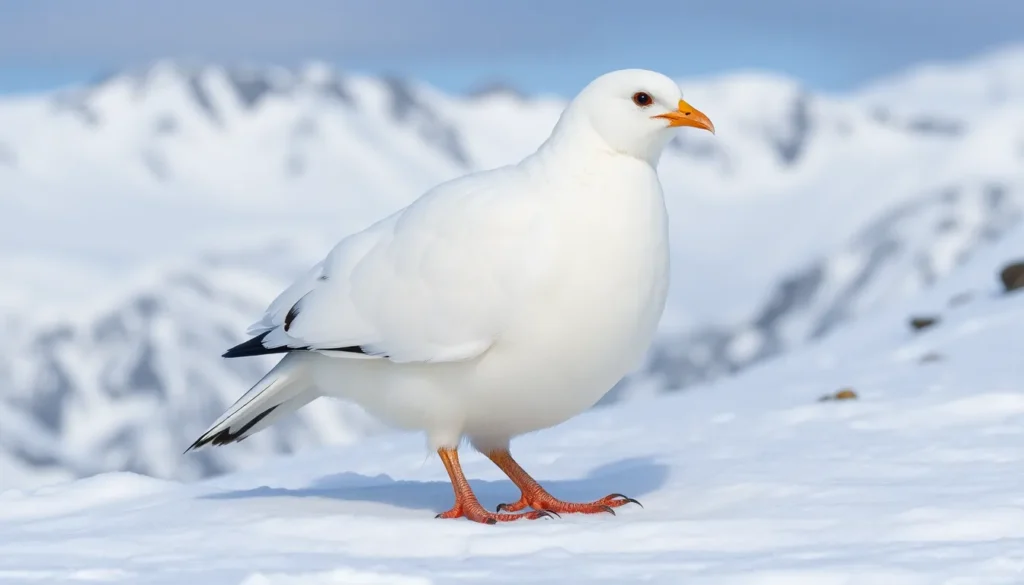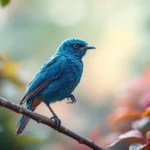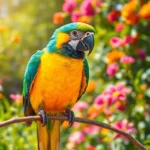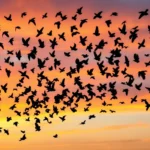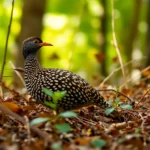We’ve all heard of birds that migrate south for winter but few know about the remarkable ptarmigan – nature’s ultimate cold-weather survivor. These extraordinary birds don’t just endure harsh Arctic conditions; they’ve mastered the art of thriving in environments that would challenge even the hardiest wildlife.
What makes ptarmigans truly fascinating is their incredible ability to transform with the seasons. While most birds simply fly away from winter weather these resilient creatures completely change their appearance and behavior to match their surroundings. From their feathered feet that work like natural snowshoes to their chameleon-like color changes ptarmigans represent one of evolution’s most impressive adaptations.
Whether you’re a bird enthusiast or simply curious about Arctic wildlife understanding ptarmigans opens up a industry of discovery about survival adaptation and the incredible ways nature prepares its creatures for extreme conditions. Let’s explore what makes these remarkable birds true masters of their frozen domain.
What Is a Ptarmigan Bird?
Ptarmigans are grouse species that belong to the genus Lagopus within the family Phasianidae. These Arctic birds measure between 13 to 16 inches in length and weigh approximately 14 to 23 ounces depending on the species and season.
Three distinct ptarmigan species exist across circumpolar regions: the willow ptarmigan (Lagopus lagopus), rock ptarmigan (Lagopus muta), and white-tailed ptarmigan (Lagopus leucura). Each species occupies exact habitat niches from sea level tundra to alpine environments above 14,000 feet elevation.
Ptarmigans display the most dramatic seasonal plumage changes among all bird species. During summer months, their feathers showcase mottled brown, gray, and white patterns that blend perfectly with rocky terrain and vegetation. Winter transforms their appearance completely as they develop pure white plumage except for black tail feathers and eye patches in males.
Feathered feet distinguish ptarmigans from all other grouse species and most bird families worldwide. Dense feather coverage extends to their toes, creating natural snowshoes that distribute weight across snow surfaces and provide insulation against freezing temperatures reaching minus 40 degrees Fahrenheit.
These birds inhabit some of Earth’s most challenging environments including Arctic tundra, alpine zones, and subarctic regions across Alaska, northern Canada, Greenland, northern Scandinavia, and high mountain ranges. Unlike most Arctic bird species, ptarmigans remain in their territories year round rather than migrating to warmer climates.
Ptarmigans consume diverse plant materials including willow buds, birch catkins, berries, leaves, and flowers during summer months. Winter diet consists primarily of woody twigs, buds, and bark from shrubs that remain above snow level.
Female ptarmigans create ground nests in shallow depressions lined with grass, feathers, and moss. Clutch sizes typically range from 6 to 10 eggs with incubation periods lasting 21 to 24 days depending on weather conditions and species.
Physical Characteristics and Seasonal Changes
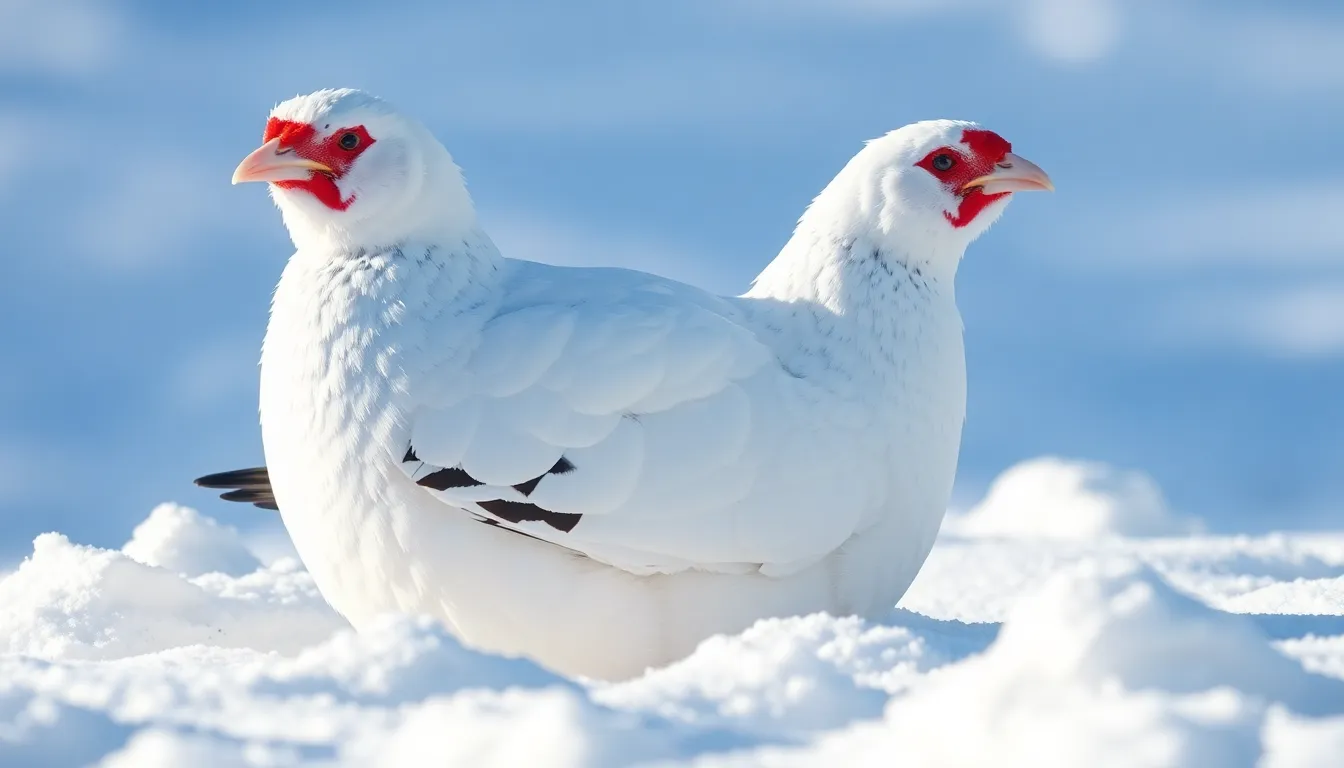
Ptarmigan birds display remarkable physical adaptations that enable survival in extreme Arctic environments. Their distinctive features change dramatically throughout the year to match environmental conditions.
Seasonal Plumage Variations
Ptarmigans undergo complete plumage transformations 3 times annually, creating one of nature’s most impressive camouflage systems. Summer plumage features intricate patterns of brown, gray, and white mottled feathers that blend seamlessly with tundra vegetation and rocky terrain. Fall brings intermediate plumage with increased white patches as birds prepare for winter conditions.
Winter plumage transforms ptarmigans into living snowballs with pure white feathers covering their entire bodies except for black tail feathers. Males retain distinctive black eye patches and red combs above their eyes during breeding season. Rock ptarmigans develop the most extensive white coverage, while willow ptarmigans maintain slightly more brown markings on their backs.
Feather density increases by 40% during winter months, providing enhanced insulation against temperatures dropping to -40°F. Molting occurs gradually over 6 to 8 weeks, ensuring birds maintain protective coloration throughout the transition period.
Size and Body Structure
Adult ptarmigans measure 13 to 16 inches in length with wingspans reaching 22 to 24 inches across species. Body weight varies seasonally from 14 to 23 ounces, with birds gaining 20% more weight before winter.
| Species | Length (inches) | Weight (ounces) | Wingspan (inches) |
|---|---|---|---|
| Willow Ptarmigan | 15-16 | 16-23 | 22-24 |
| Rock Ptarmigan | 13-14 | 14-19 | 20-22 |
| White-tailed Ptarmigan | 13-15 | 14-18 | 20-22 |
Their most distinctive feature consists of heavily feathered feet and toes that function as natural snowshoes. These feather coverings extend completely over their claws, providing traction on ice and preventing heat loss through extremities. Ptarmigan legs appear significantly thicker than other grouse species due to this extensive feathering.
Compact body structure minimizes surface area exposed to cold temperatures. Their rounded heads feature small beaks adapted for accessing buried vegetation beneath snow layers. Wings remain relatively short but powerful enough for quick escape flights over rough terrain.
Ptarmigan Species and Geographic Distribution
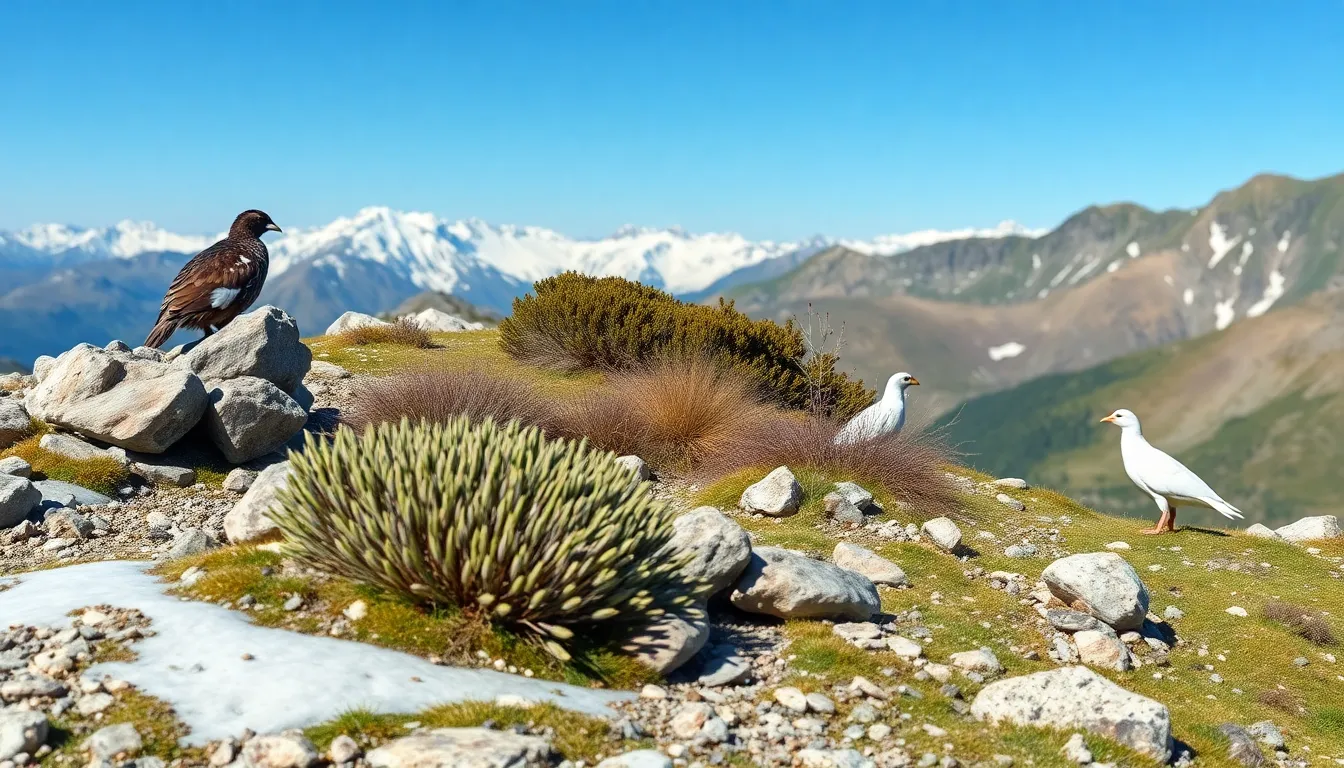
Three distinct ptarmigan species inhabit diverse Arctic and alpine regions across the Northern Hemisphere. Each species occupies exact elevational zones and geographic ranges that reflect their unique evolutionary adaptations.
Rock Ptarmigan
Rock ptarmigans (Lagopus muta) represent the most widespread ptarmigan species across the Arctic. These hardy birds inhabit rocky terrain and alpine zones throughout Alaska, northern Canada, Greenland, Iceland, Scandinavia, and high mountain ranges of Europe and Asia.
Elevation preferences for rock ptarmigans extend from sea level in Arctic regions up to 14,100 feet in alpine environments. Their distribution spans approximately 15 million square kilometers across the Northern Hemisphere, making them one of the most geographically extensive bird species.
Rock ptarmigans display the most dramatic seasonal color changes among ptarmigan species. Males retain distinctive black eye patches year-round, while females show more subtle markings during breeding season.
Willow Ptarmigan
Willow ptarmigans (Lagopus lagopus) occupy lower elevations and more vegetated habitats compared to their rock-dwelling relatives. Their range includes Alaska, northern Canada, northern Scandinavia, and subarctic regions of Russia and Siberia.
These birds prefer shrubland and wetland areas where willow and birch vegetation provides abundant food sources. Willow ptarmigans typically inhabit elevations below 3,000 feet in most regions, though they reach higher altitudes in mountainous areas.
Population densities of willow ptarmigans fluctuate significantly, with peak numbers occurring every 8 to 12 years. Their distribution closely follows the treeline boundary in northern regions, where they exploit the transition zone between forest and tundra.
White-Tailed Ptarmigan
White-tailed ptarmigans (Lagopus leucura) represent the smallest ptarmigan species and occupy the highest elevations. Their natural range includes the Rocky Mountains from Alaska through British Columbia, Montana, Colorado, and isolated populations in the Cascade Range.
Alpine environments above 7,000 feet provide the primary habitat for white-tailed ptarmigans. These birds inhabit areas characterized by exposed rock, alpine meadows, and scattered vegetation patches that remain snow-free during summer months.
White-tailed ptarmigans demonstrate the most restricted geographic distribution among ptarmigan species. Their populations remain stable but localized, with successful transplant programs establishing new colonies in the Sierra Nevada and Uinta Mountains during the 20th century.
Habitat and Environmental Preferences
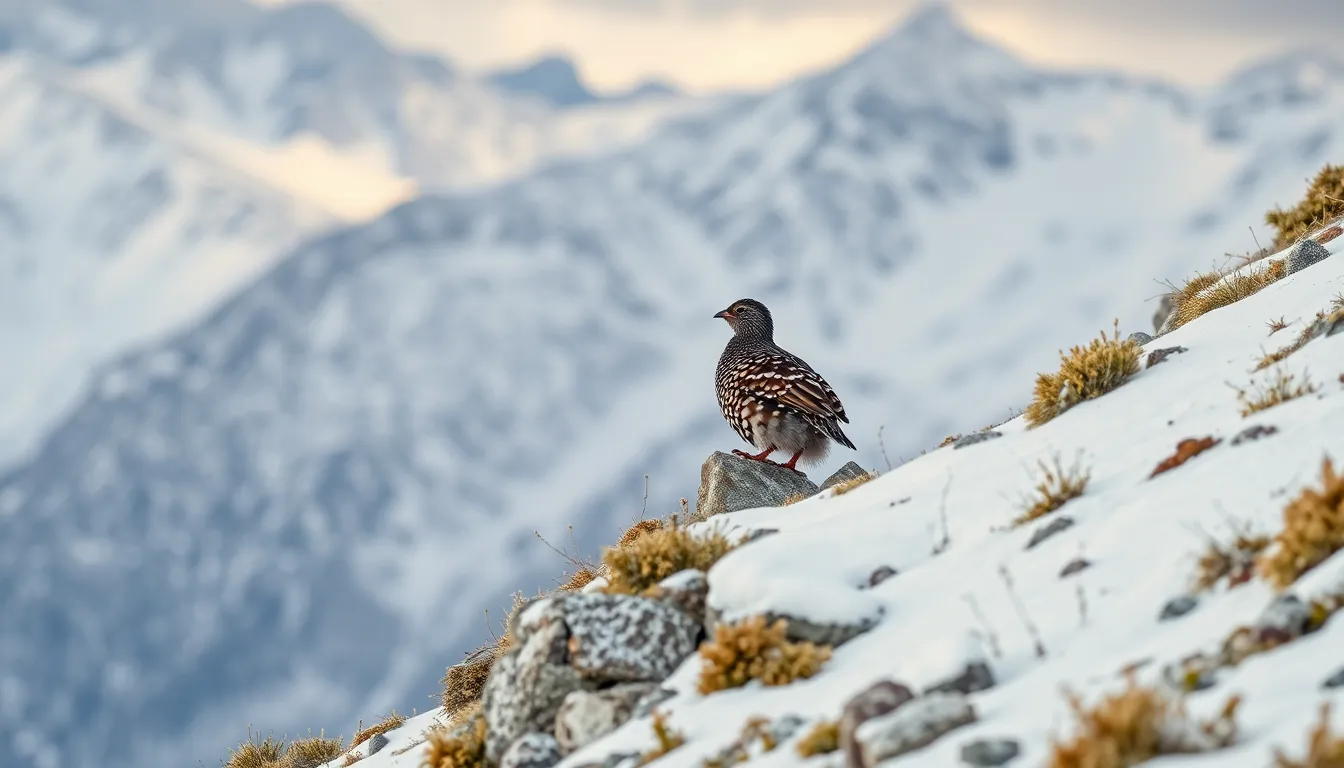
Ptarmigans occupy some of Earth’s most extreme environments, from Arctic tundra at sea level to alpine zones exceeding 14,000 feet in elevation. These birds demonstrate remarkable habitat flexibility across their range, with each species selecting exact environmental niches that match their evolutionary adaptations.
Arctic tundra serves as the primary habitat for both rock and willow ptarmigans, where temperatures can plummet to -40°F during winter months. Willow ptarmigans favor lower elevation areas with dense shrub vegetation, particularly regions dominated by willow, birch, and alder bushes that provide both food and shelter. Rock ptarmigans choose higher elevation rocky terrain with sparse vegetation, including exposed ridges and boulder fields where wind keeps snow accumulation minimal.
White-tailed ptarmigans exclusively inhabit alpine environments in the Rocky Mountains, thriving at elevations between 11,000 and 14,000 feet. Mountain meadows, talus slopes, and areas near treeline create ideal conditions for this species throughout their range from Alaska to New Mexico.
Temperature extremes define ptarmigan habitat preferences, with these birds tolerating winter conditions as low as -58°F in northern Alaska. Snow depth significantly influences their habitat selection, as ptarmigans prefer areas where wind exposure prevents excessive accumulation that could bury food sources. Precipitation patterns affect their breeding success, with optimal nesting occurring in regions receiving 10 to 20 inches of annual precipitation.
Vegetation composition determines ptarmigan habitat quality across seasons. Summer habitats feature diverse plant communities including sedges, grasses, berries, and flowering plants that provide essential nutrition during breeding season. Winter environments require accessible woody vegetation like willow and birch twigs that remain above snow level.
| Environmental Factor | Optimal Range | Impact on Ptarmigans |
|---|---|---|
| Elevation | Sea level – 14,000 feet | Species-exact distribution |
| Temperature | -58°F to 60°F | Influences plumage changes |
| Snow Depth | Less than 3 feet | Affects food accessibility |
| Wind Exposure | Moderate to high | Prevents excessive snow buildup |
| Annual Precipitation | 10-20 inches | Impacts vegetation growth |
Microhabitat selection varies throughout the year as ptarmigans move between feeding, roosting, and nesting areas. During severe weather, they seek shelter in snow burrows that provide insulation and protection from wind. Breeding females select nest sites on well-drained slopes with adequate cover from predators and easy access to food sources.
Human activity increasingly influences ptarmigan habitat preferences, with climate change causing vegetation shifts at higher elevations. Mining, development, and recreational activities in alpine regions create habitat fragmentation that affects local populations. Conservation efforts focus on protecting large contiguous areas of suitable habitat across elevation gradients.
Seasonal habitat shifts reflect changing environmental conditions and food availability throughout the year. Spring migration patterns bring ptarmigans from winter refugia to breeding territories, while autumn movements position birds in areas with reliable winter food sources and appropriate snow conditions for survival.
Diet and Feeding Behavior
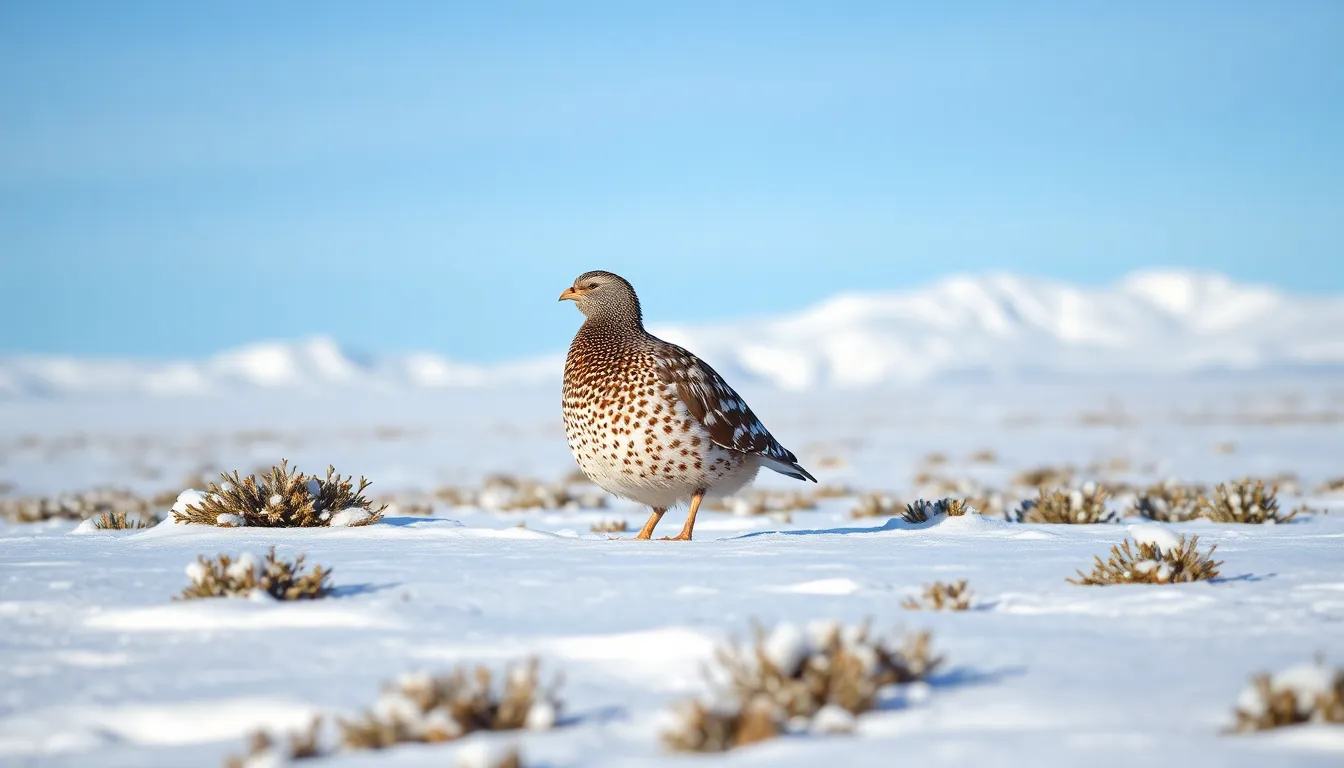
Ptarmigan birds demonstrate remarkable dietary flexibility that directly corresponds to their seasonal survival strategies. We observe these Arctic specialists consuming over 200 different plant species throughout their annual cycle, with their feeding patterns shifting dramatically between summer abundance and winter scarcity.
During summer months, ptarmigans consume primarily soft vegetation including willow leaves, berries, flowers, and tender shoots. Bilberries, crowberries, and lingonberries comprise up to 60% of their summer diet, providing essential nutrients for breeding and molt preparation. Seeds from sedges and grasses supplement their nutritional intake during the brief Arctic growing season.
Winter feeding behavior transforms completely as ptarmigans adapt to snow-covered landscapes. Woody twigs and buds from willow, birch, and alder trees become their primary sustenance, with these materials making up 85% of their winter diet. Catkins from birch trees provide crucial protein sources when other vegetation remains inaccessible beneath snow.
| Season | Primary Food Sources | Percentage of Diet | Key Nutrients |
|---|---|---|---|
| Summer | Berries and leaves | 60% | Antioxidants, vitamins |
| Summer | Seeds and flowers | 40% | Carbohydrates, protein |
| Winter | Woody twigs and buds | 85% | Fiber, minimal protein |
| Winter | Bark and catkins | 15% | Protein, essential oils |
Foraging techniques vary significantly between species based on their habitat preferences. Rock ptarmigans excavate snow to access buried vegetation using their strong feet, often digging tunnels up to 3 feet deep. Willow ptarmigans strip buds directly from exposed branches above snow level, while white-tailed ptarmigans navigate steep alpine slopes to locate wind-exposed plant materials.
Chicks require specialized diets rich in protein for proper development. Newly hatched ptarmigans consume insects, spiders, and other invertebrates during their first 10 days of life, with arthropods comprising 90% of their intake. Adult females guide chicks to areas with high insect density, particularly around flowering plants that attract diverse arthropod communities.
Daily feeding patterns reflect energy conservation strategies essential for Arctic survival. Ptarmigans feed most actively during early morning and late afternoon hours, spending 4 to 6 hours daily foraging during summer. Winter feeding sessions become more intensive but shorter, typically lasting 2 to 3 hours as birds focus on high-energy food sources.
Seasonal weight fluctuations demonstrate the effectiveness of ptarmigan feeding strategies. Birds gain 20 to 30% of their body weight during late summer, building fat reserves that sustain them through harsh winter conditions. Spring weight loss of 15 to 25% indicates successful survival through the most challenging months of their annual cycle.
Breeding and Nesting Habits
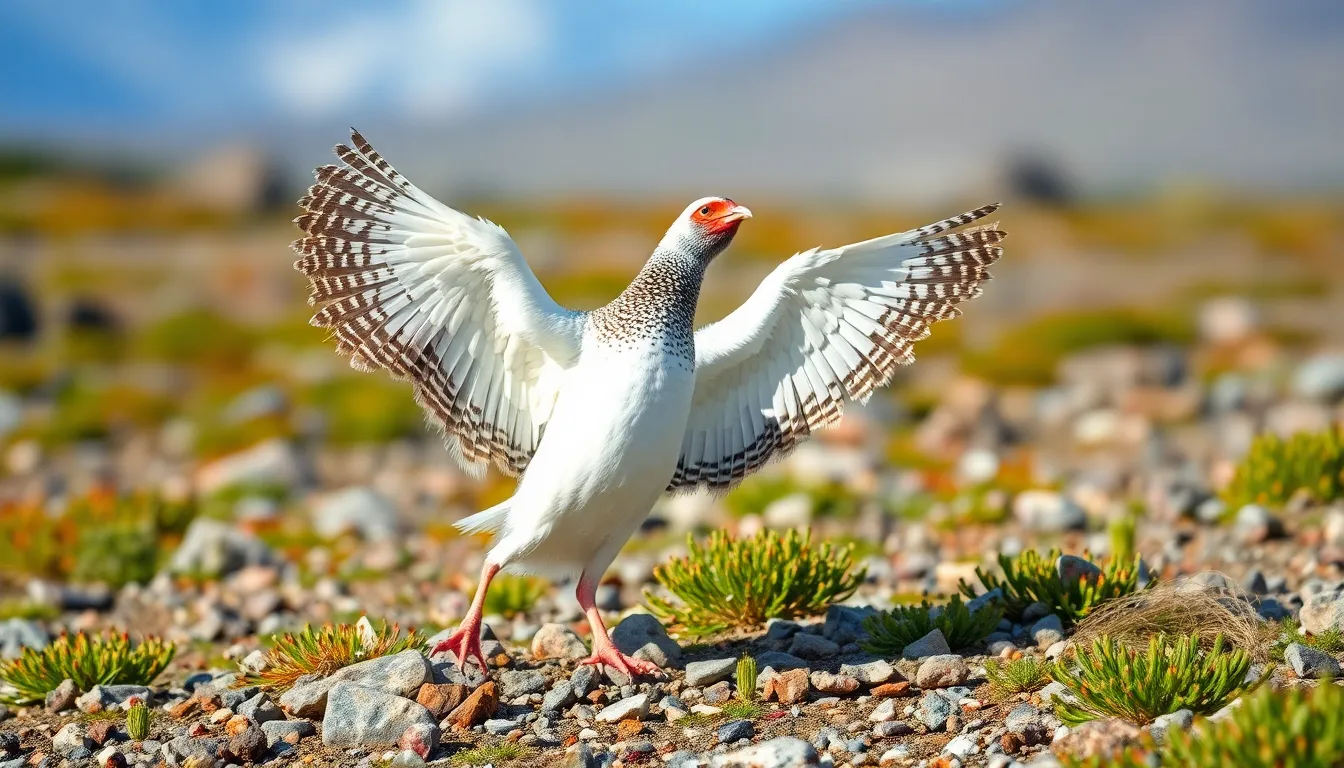
Ptarmigan breeding patterns demonstrate remarkable timing precision that aligns perfectly with Arctic seasonal changes. These birds concentrate their reproductive activities within the brief Arctic summer window when food sources become abundant and weather conditions support successful chick survival.
Mating Rituals
Male ptarmigans establish territories during April and May using elaborate displays that include aerial flights, ground strutting, and distinctive vocal calls. Willow ptarmigan males perform the most dramatic courtship displays, featuring neck stretching, tail fanning, and aggressive posturing to attract females and ward off competing males. Rock ptarmigan males use rocky outcrops as display platforms, executing jumping displays while producing harsh, rattling calls that carry across alpine valleys.
Territorial boundaries span 2 to 5 acres per pair, with males defending these areas through continuous patrolling and vocal challenges. Courtship displays intensify during peak breeding season, which typically occurs between mid-May and early June depending on elevation and latitude. Female selection focuses on males demonstrating superior territory quality, robust physical condition, and consistent display behaviors that indicate genetic fitness.
Pair bonds form monogamously for single breeding seasons, though some individuals may maintain partnerships across multiple years if both birds survive winter conditions. Males accompany females during nest site selection, providing protection while females evaluate potential locations based on vegetation cover, drainage, and proximity to food sources.
Chick Development
Female ptarmigans construct shallow ground depressions lined with grass, moss, and their own breast feathers to create insulated nest environments. Clutch sizes average 8 to 10 eggs for willow ptarmigans, 6 to 8 eggs for rock ptarmigans, and 4 to 7 eggs for white-tailed ptarmigans, with larger clutches correlating to favorable environmental conditions and female body condition.
Incubation lasts 21 to 24 days exclusively by females, who leave nests only for brief feeding periods during early morning and late evening hours. Eggs hatch synchronously within 6 to 12 hours, producing precocial chicks covered in dense, cryptically patterned down that provides immediate camouflage against predators.
Newly hatched ptarmigan chicks weigh approximately 0.4 to 0.6 ounces and demonstrate remarkable mobility within hours of emergence. Protein requirements drive chick feeding behavior during the first 10 days, with young birds consuming primarily insects including midges, mosquitoes, and small beetles that provide essential amino acids for rapid growth.
Family groups remain together for 10 to 12 weeks while chicks develop flight capabilities and adult foraging skills. Males participate actively in brood protection, creating distraction displays when predators approach and leading chicks to safe foraging areas with abundant insect populations. Chick mortality rates range from 30% to 60% depending on weather conditions, predator pressure, and food availability during the critical first month of life.
Flight development occurs gradually over 2 to 3 weeks, with young ptarmigans achieving full flight capability by 8 to 10 weeks of age. Adult plumage replacement begins during late summer, preparing juvenile birds for their first winter survival challenge in harsh Arctic conditions.
Survival Adaptations in Harsh Climates
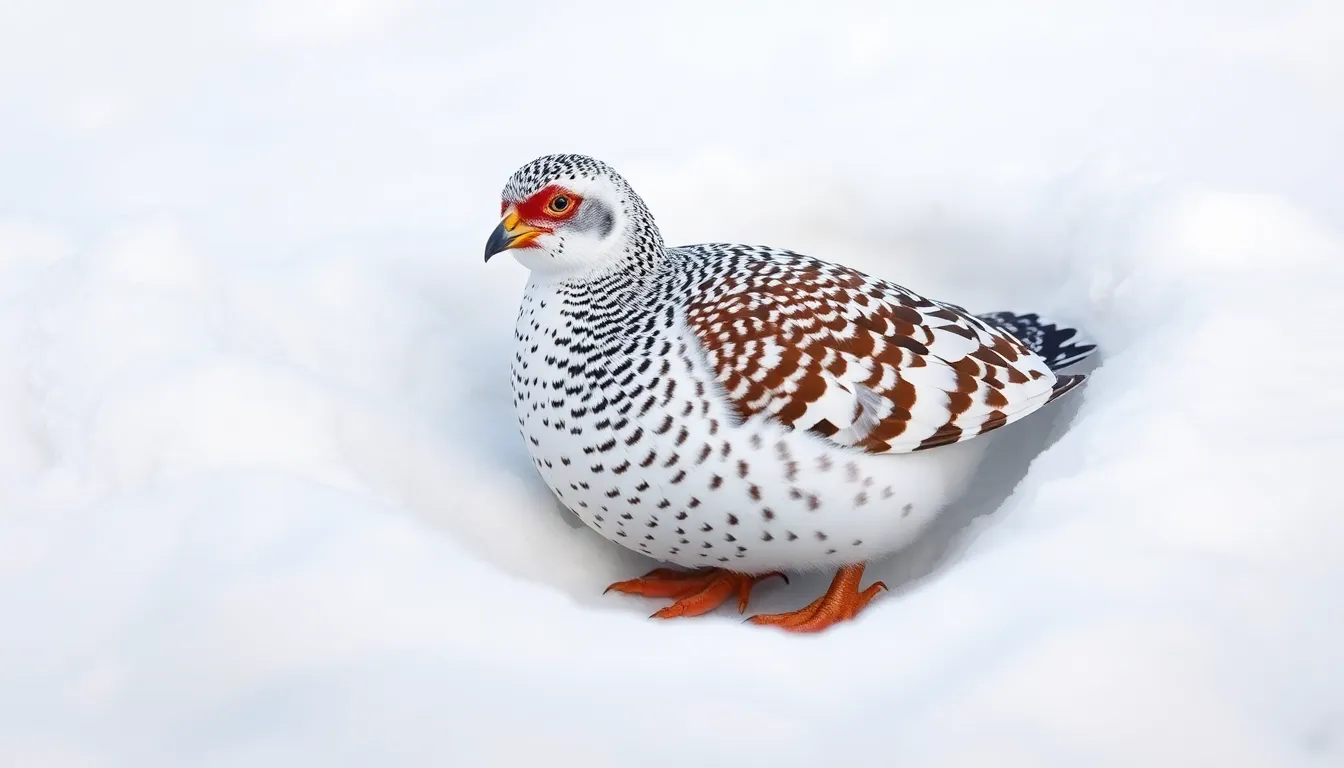
Survival adaptations in harsh climates define ptarmigan birds as nature’s ultimate Arctic specialists. These remarkable birds survive temperatures plunging to -40°F through multiple physiological and behavioral modifications that work together as an integrated survival system.
Thermoregulation Mechanisms
Thermoregulation mechanisms allow ptarmigans to maintain core body temperatures even though extreme cold exposure. Dense feather coverage increases by 40% during winter months, creating multiple insulation layers that trap warm air close to the skin. Counter-current heat exchange systems in their legs prevent heat loss through blood circulation patterns that warm returning venous blood using arterial heat.
Behavioral thermoregulation includes snow burrow construction during blizzards and extreme cold snaps. Ptarmigans dig temporary shelters 12 to 18 inches deep in soft snow, creating microenvironments that remain 20 to 30 degrees warmer than surface temperatures. Communal roosting behaviors during severe weather events provide additional heat conservation through shared body warmth.
Metabolic Adjustments
Metabolic adjustments enable ptarmigans to conserve energy during winter resource scarcity. Basal metabolic rates decrease by approximately 15% during winter months, reducing overall energy expenditure while maintaining essential bodily functions. Fat storage strategies begin in late summer when ptarmigans accumulate body fat reserves comprising up to 25% of their total body weight.
Digestive system modifications allow efficient processing of low-quality winter vegetation. Crop enlargement during winter months accommodates larger food volumes, while longer food retention times maximize nutrient extraction from woody plant materials. Specialized gut bacteria populations assist in cellulose breakdown from twigs and bark consumed during months of limited food availability.
Camouflage and Predator Avoidance
Camouflage adaptations provide ptarmigans with exceptional protection from aerial and terrestrial predators. Complete plumage color changes occur three times annually, transitioning from mottled brown summer patterns to pure white winter coloration. Molting processes coordinate with seasonal environmental changes, ensuring optimal camouflage effectiveness throughout the year.
Freezing behaviors complement visual camouflage when predators approach within detection range. Ptarmigans remain motionless for extended periods, relying on their cryptic coloration to avoid predator recognition. Explosive flight patterns confuse pursuing raptors through rapid directional changes and low-altitude maneuvering over rocky terrain.
Snow adaptation features include feathered feet that function as natural snowshoes, distributing body weight across soft snow surfaces. Toe feathers provide traction on icy surfaces while preventing heat loss through extremities exposed to frozen ground contact.
Conservation Status and Threats
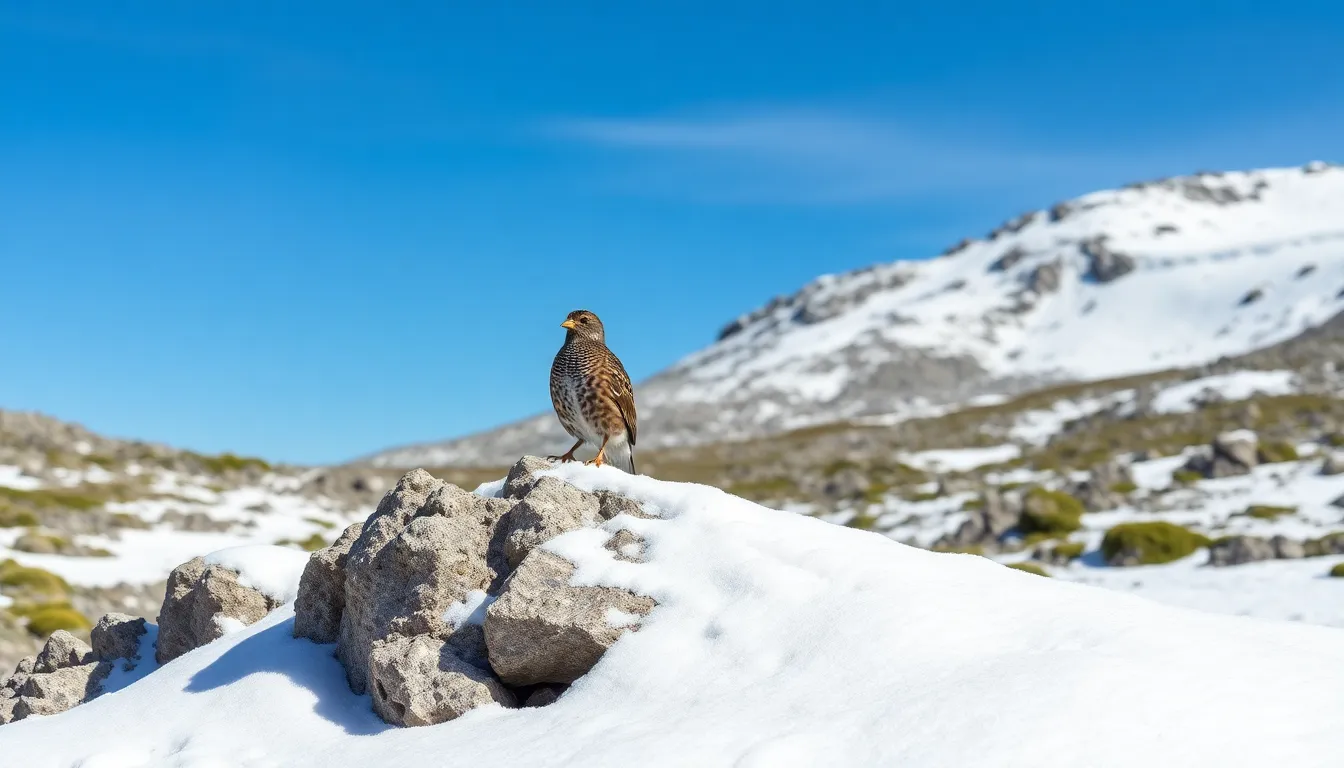
Ptarmigan conservation status varies significantly across the three species, with climate change emerging as the primary threat to their survival. The International Union for Conservation of Nature (IUCN) currently lists all three ptarmigan species as “Least Concern,” though population trends show concerning declines in several regions.
Rock ptarmigans face the most widespread challenges, with populations declining by approximately 2% annually across their circumpolar range. Climate warming forces these birds to higher elevations, reducing available habitat by an estimated 67% over the next 50 years. Temperature increases of just 2°C can eliminate entire breeding territories at lower elevations.
Willow ptarmigans experience more variable population trends, with some regions showing stable numbers while others face important declines. Alaska’s populations remain relatively steady at approximately 2.5 million birds, whereas Scandinavian populations have decreased by 30% since 1980. Habitat fragmentation affects their preferred shrubland environments, particularly in areas experiencing human development.
White-tailed ptarmigans occupy the most vulnerable position among the three species due to their restricted high-altitude habitats. These birds inhabit elevations above 11,000 feet, making them extremely susceptible to warming temperatures. Research indicates their suitable habitat could shrink by 80% by 2100 under current climate projections.
Primary Threats Affecting Ptarmigan Populations
| Threat Category | Impact Level | Affected Species | Population Effect |
|---|---|---|---|
| Climate Change | High | All three species | 15-30% decline projected |
| Habitat Loss | Medium-High | Willow, Rock | Variable by region |
| Predation Changes | Medium | All species | Localized impacts |
| Human Disturbance | Low-Medium | Regional populations | Tourism effects |
| Hunting Pressure | Low | Willow primarily | Regulated harvest |
Climate change represents the most important long-term threat to ptarmigan survival. Rising temperatures alter vegetation patterns, reduce snow cover duration, and shift the timing of seasonal transitions that ptarmigans depend upon for breeding success. Arctic regions are warming twice as fast as global averages, creating rapid habitat changes that exceed these birds’ adaptive capabilities.
Predator dynamics have shifted dramatically in response to climate change, affecting ptarmigan mortality rates. Red foxes are expanding their range northward as temperatures warm, competing with Arctic foxes and increasing predation pressure on ground-nesting ptarmigans. Research shows red fox presence correlates with 40% lower ptarmigan breeding success in newly invaded territories.
Habitat fragmentation from infrastructure development creates additional challenges for ptarmigan populations. Mining operations, roads, and energy projects fragment continuous tundra habitats, reducing breeding territory quality and increasing mortality risks. Human disturbance from recreational activities affects breeding success rates, with studies documenting 25% lower nesting success within 500 meters of hiking trails.
Vegetation changes linked to climate warming alter food availability and habitat structure. Shrub expansion in tundra regions initially appears beneficial but eventually reduces the open habitats ptarmigans prefer. Tree line advancement eliminates alpine zones, forcing white-tailed ptarmigans into increasingly restricted high-elevation refugia.
Conservation Efforts and Management Strategies
Conservation initiatives focus on habitat protection and climate change mitigation to address ptarmigan population declines. Protected area networks across the Arctic and alpine regions provide refuge habitat, though these areas require expansion to accommodate shifting species distributions. International cooperation between Arctic nations coordinates research efforts and conservation planning across ptarmigan ranges.
Monitoring programs track population trends and habitat changes using standardized survey methods. Long-term datasets spanning 40+ years provide crucial baseline information for conservation decision-making. Citizen science programs engage hunters and birdwatchers in data collection, expanding monitoring coverage across remote ptarmigan habitats.
Research priorities include understanding climate change impacts on reproduction, survival, and habitat requirements. Scientists use satellite telemetry to track movements and habitat use patterns, providing insights into how ptarmigans respond to environmental changes. Genetic studies assess population connectivity and identify potential climate refugia for conservation prioritization.
Adaptive management strategies acknowledge that traditional conservation approaches require modification in response to rapid climate change. Conservation plans incorporate climate projections to identify future habitat corridors and refuge areas. Assisted migration programs may become necessary for isolated populations facing habitat loss, though such interventions remain controversial and require careful evaluation.
Ptarmigan Bird Watching Tips
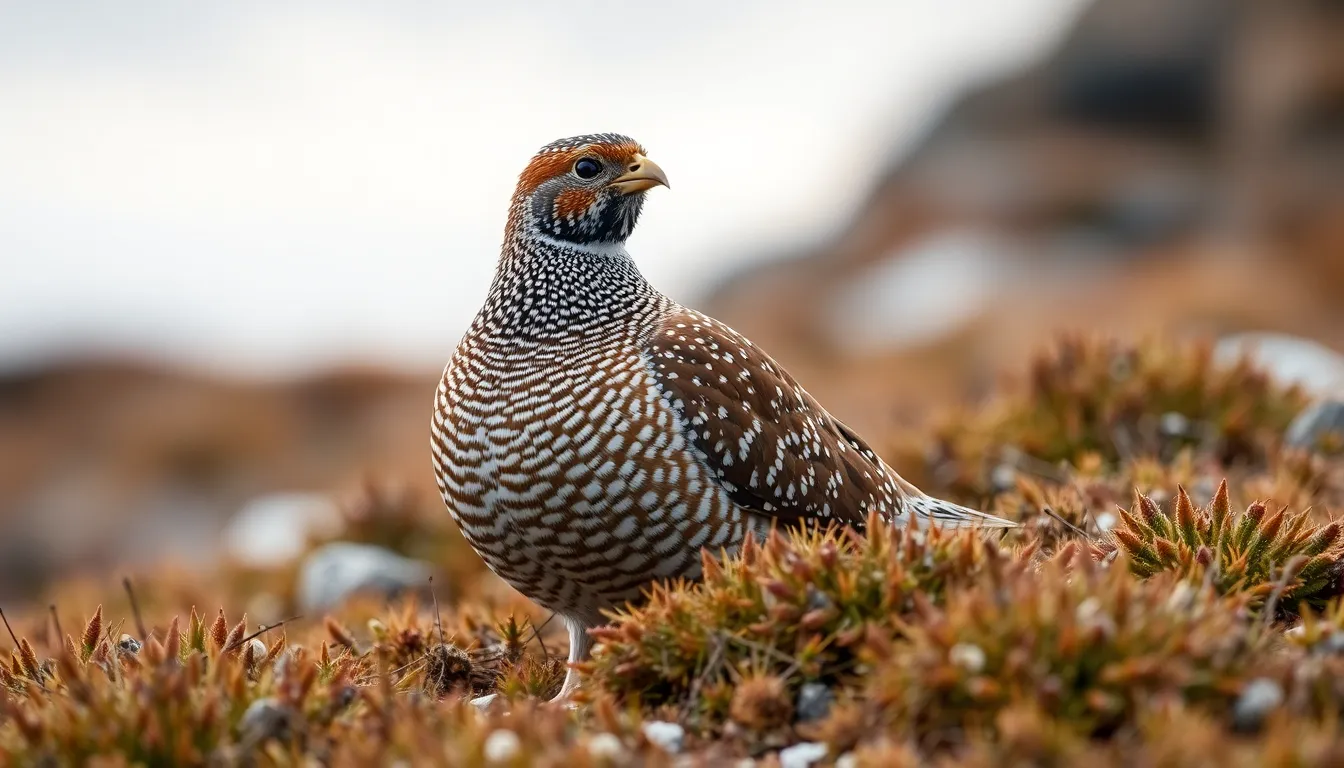
Ptarmigan bird watching requires exact techniques and timing to successfully observe these elusive Arctic specialists. We recommend planning expeditions during early morning hours between 6:00 and 9:00 AM when ptarmigans are most active and feeding.
Best Times and Seasons for Observation
Summer months from June through August offer optimal viewing conditions as ptarmigans exhibit mottled brown and white plumage against tundra vegetation. Winter observations present unique challenges but reward watchers with pure white birds that blend seamlessly with snow-covered landscapes. Spring migration periods from April to May provide excellent opportunities to witness dramatic plumage transformations as birds molt from winter white to summer camouflage.
Temperature conditions below 50°F typically increase ptarmigan activity levels during daylight hours. Overcast days reduce shadows and glare, making it easier to spot these well-camouflaged birds against rocky terrain or vegetation.
Equipment and Gear Recommendations
High-quality binoculars with 8×42 or 10×50 magnification provide the minimum optical power needed to identify ptarmigans at distances of 100 to 300 yards. Spotting scopes with 20x to 60x magnification prove essential for detailed observation of plumage patterns and behavioral displays.
| Equipment Type | Specifications | Purpose |
|---|---|---|
| Binoculars | 8×42 or 10×50 | General observation |
| Spotting Scope | 20x-60x zoom | Detailed study |
| Camera Lens | 400mm minimum | Photography |
| Tripod | Carbon fiber, lightweight | Stability |
Warm, layered clothing in earth tones helps maintain body temperature during extended observation periods in harsh climates. Waterproof boots with good traction become necessary when traversing rocky alpine terrain or wet tundra conditions.
Identifying Different Species in the Field
Rock ptarmigans inhabit higher elevations above treeline and display more pronounced black eye patches in males during breeding season. Their preference for rocky outcrops and scree slopes distinguishes them from other species in overlapping ranges.
Willow ptarmigans frequent lower elevation areas with dense shrub vegetation and show larger body sizes compared to their alpine relatives. Males develop distinctive red combs above their eyes during courtship displays from April through June.
White-tailed ptarmigans remain the smallest of the three species and occupy the highest mountain elevations exceeding 11,000 feet. Their white tail feathers remain visible year-round, contrasting with the black tail feathers of rock and willow ptarmigans.
Behavioral Cues for Location
Ptarmigans exhibit freezing behavior when threatened, remaining motionless for several minutes before exploding into flight with rapid wingbeats. Listen for their distinctive calls: rock ptarmigans produce harsh croaking sounds, while willow ptarmigans emit softer clucking vocalizations.
Scratching sounds in snow or vegetation often indicate feeding activity as ptarmigans dig for buried plant material or create snow burrows for shelter. Fresh tracks measuring 2 to 3 inches in length show four toe impressions with visible feather marks extending beyond the foot pad.
Courtship displays during breeding season involve males performing elaborate wing-fluttering flights combined with territorial calls that can be heard from distances up to half a mile. These aerial displays typically occur on ridge tops or open areas where visibility extends across the industry.
Conclusion
We’ve explored the extraordinary industry of ptarmigans and their unmatched ability to thrive in some of Earth’s most challenging environments. These remarkable Arctic specialists demonstrate nature’s incredible capacity for adaptation through their seasonal transformations and survival strategies.
Understanding ptarmigans helps us appreciate the delicate balance of Arctic ecosystems and the urgent need for conservation action. As climate change continues to reshape their habitats we must recognize these birds as valuable indicators of environmental health.
Whether you’re planning your first ptarmigan watching expedition or simply fascinated by wildlife adaptation these incredible birds offer endless opportunities for discovery. Their story reminds us that even in the harshest conditions life finds remarkable ways to flourish and adapt.
Frequently Asked Questions
What are ptarmigans and where do they live?
Ptarmigans are Arctic grouse species belonging to the genus Lagopus that inhabit some of Earth’s harshest environments, including Arctic tundra and alpine zones. Unlike most Arctic birds, they remain in their territories year-round rather than migrating. These remarkable birds measure 13-16 inches in length and have evolved exceptional adaptations to survive extreme cold and challenging conditions.
How many ptarmigan species exist and how are they different?
There are three distinct ptarmigan species: willow ptarmigan (prefers lower elevations and vegetated habitats), rock ptarmigan (inhabits rocky terrain and alpine zones, most widespread), and white-tailed ptarmigan (smallest species, occupies highest elevations in Rocky Mountains). Each species has unique adaptations suited to their specific environments and altitude preferences.
How do ptarmigans change their appearance seasonally?
Ptarmigans undergo complete plumage transformations three times yearly. Summer plumage features mottled brown, gray, and white patterns that blend with tundra vegetation. Winter plumage turns pure white except for black tail feathers and eye patches in males. Their feather density increases by 40% in winter, providing crucial insulation against frigid temperatures.
What do ptarmigans eat throughout the year?
Ptarmigans exhibit remarkable dietary flexibility aligned with seasonal survival strategies. During summer, they consume soft vegetation including berries, leaves, and plant materials like willow buds. In winter, their diet shifts to woody twigs and buds. Newly hatched chicks require protein-rich diets consisting primarily of insects for proper development and rapid growth.
How do ptarmigans breed and care for their young?
Female ptarmigans build ground nests with clutch sizes of 6-10 eggs, incubating them for 21-24 days. Males establish territories through elaborate courtship displays, forming monogamous pair bonds for single breeding seasons. Chicks hatch synchronously as precocial young, and family groups stay together for several weeks while chicks develop flight capabilities.
What special adaptations help ptarmigans survive extreme cold?
Ptarmigans have feathered feet that act like snowshoes for traction and warmth. They construct snow burrows for insulation and undergo metabolic adjustments including reduced basal metabolic rates and fat storage. Their compact bodies, increased winter feather density, and thermoregulation mechanisms help maintain core body temperatures in extreme conditions.
Are ptarmigans endangered or threatened?
Currently, all three ptarmigan species are listed as “Least Concern” by IUCN, but population declines are evident. Climate change is the primary threat, particularly affecting rock ptarmigans through habitat loss. White-tailed ptarmigans are most vulnerable due to restricted high-altitude habitats. Conservation efforts focus on habitat protection and climate change mitigation strategies.
When and where is the best time to observe ptarmigans?
Early morning expeditions offer optimal ptarmigan observation opportunities. Summer provides the best viewing season when birds are more active and visible. Recommended equipment includes binoculars, spotting scopes, and appropriate cold-weather clothing. Look for behavioral cues like courtship displays and listen for their distinctive calls to locate these elusive Arctic specialists.

